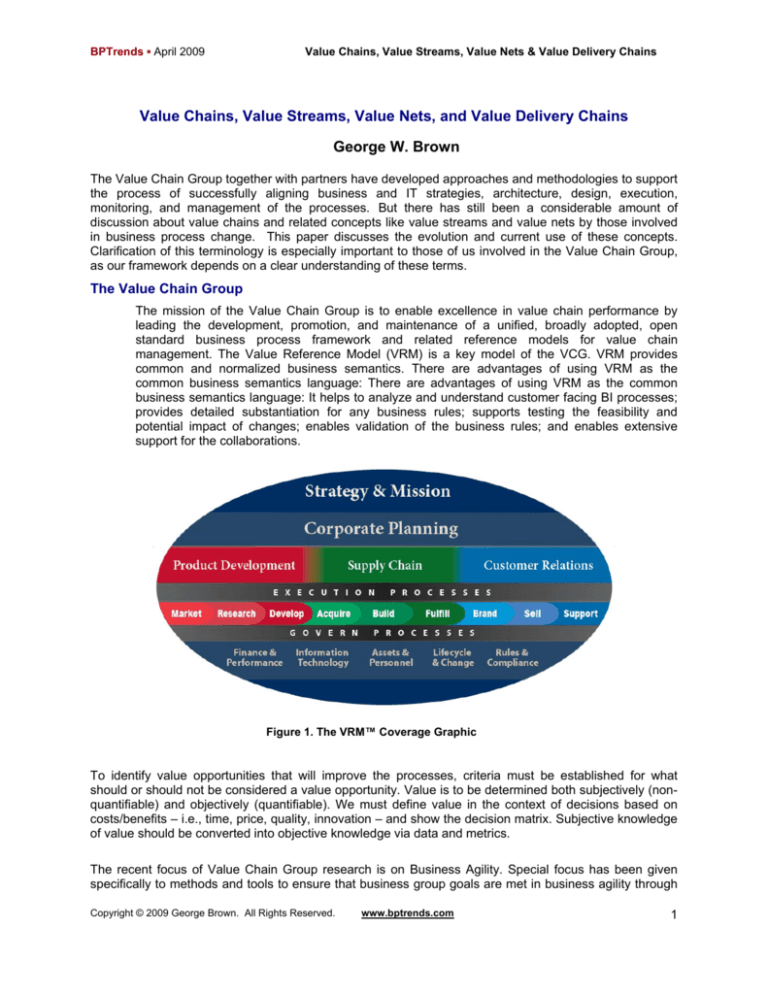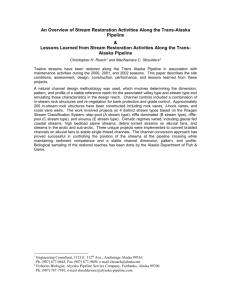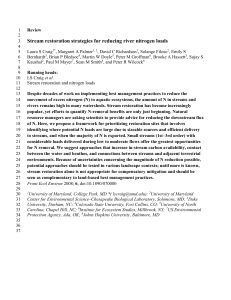
BPTrends ▪ April 2009
Value Chains, Value Streams, Value Nets & Value Delivery Chains
Value Chains, Value Streams, Value Nets, and Value Delivery Chains
George W. Brown
The Value Chain Group together with partners have developed approaches and methodologies to support
the process of successfully aligning business and IT strategies, architecture, design, execution,
monitoring, and management of the processes. But there has still been a considerable amount of
discussion about value chains and related concepts like value streams and value nets by those involved
in business process change. This paper discusses the evolution and current use of these concepts.
Clarification of this terminology is especially important to those of us involved in the Value Chain Group,
as our framework depends on a clear understanding of these terms.
The Value Chain Group
The mission of the Value Chain Group is to enable excellence in value chain performance by
leading the development, promotion, and maintenance of a unified, broadly adopted, open
standard business process framework and related reference models for value chain
management. The Value Reference Model (VRM) is a key model of the VCG. VRM provides
common and normalized business semantics. There are advantages of using VRM as the
common business semantics language: There are advantages of using VRM as the common
business semantics language: It helps to analyze and understand customer facing BI processes;
provides detailed substantiation for any business rules; supports testing the feasibility and
potential impact of changes; enables validation of the business rules; and enables extensive
support for the collaborations.
Figure 1. The VRM™ Coverage Graphic
To identify value opportunities that will improve the processes, criteria must be established for what
should or should not be considered a value opportunity. Value is to be determined both subjectively (nonquantifiable) and objectively (quantifiable). We must define value in the context of decisions based on
costs/benefits – i.e., time, price, quality, innovation – and show the decision matrix. Subjective knowledge
of value should be converted into objective knowledge via data and metrics.
The recent focus of Value Chain Group research is on Business Agility. Special focus has been given
specifically to methods and tools to ensure that business group goals are met in business agility through
Copyright © 2009 George Brown. All Rights Reserved.
www.bptrends.com
1
BPTrends ▪ April 2009
Value Chains, Value Streams, Value Nets & Value Delivery Chains
Value Chain Management and through the transition to SOA. Value delivery and business flexibility have
evolved through concepts of Value Chains, Value Streams, Value Nets, and Value Delivery Chains. Our
agenda is to sense operational performance and market change, assuring business agility and driving
market distinction by addressing critical areas of need for becoming an Agile Enterprise.
Value Chain Analysis or Value Stream Mapping are useful tools for working out how you can create the
greatest possible value for your customers, as well as your best route to profit maximization. Dealing with
restructuring value chains has changed considerably due to the decades of growth in electronic
commerce leveraging the internet.
This brief document covers some of the conceptual evolution of business process management through
concepts of Value Chains, Value Streams, Value Nets, and Value Delivery Chains. Some of the material
in this paper comes directly from documents that go back over 20 years, including writing by Michael
Porter, James Martin, Ralph Whittle, and David Bovet.
The value chain is a concept from business management that was first described and popularized by
Michael Porter in his 1985 best-seller, Competitive Advantage: Creating and Sustaining Superior
Performance. [1] Porter termed the larger interconnected system of value chains the "value system." [2] A
value system includes the value chains of a firm's supplier (and their suppliers all the way back), the firm
itself, the firm distribution channels, and the firm's buyers (and presumably extends to the buyers of their
products, and so on).
Figure 2. Porter’s Value Chain
Value Streams were introduced in Michael Porter’s book but were explained more clearly by James
Martin in his 1995 book, The Great Transition, which pulls together the many issues, models, and
methods for transforming the traditional old-world organization into a value-creating enterprise. [3] Martin
uses value stream, rather than process, to define the end-to-end stream of activities that deliver particular
results for a given customer (external or internal).
The 2004 book, Enterprise Business Architecture, by Ralph Whittle and Conrad Myrick, provides a
common reference model by defining the business strategy, governance, organization, and business
functions, and establishes a baseline that links strategy and results by defining which organizations
perform those functions. This book [4] provides a consistent classification of all the tasks, activities,
functions, and processes into Value Streams. For the EBA, the Value Streams are the organizing and
Copyright © 2009 George Brown. All Rights Reserved.
www.bptrends.com
2
BPTrends ▪ April 2009
Value Chains, Value Streams, Value Nets & Value Delivery Chains
unifying principle in the foundation. The book represents the initial Enterprise Business Architecture
(EBA) for companies and will serve to ensure that investments in information technology support the
business of corporations.
Figure 3. Whittle & Myrick EBA Navigation
David Bovet, a vice president at Mercer Management Consulting, co-authored Value Nets: Breaking the
Supply Chain to Unlock Hidden Profits. Inspiration for Value Nets came from the drive to design a new
networked paradigm that allows companies to fulfill customer expectations for speed, reliability,
convenience, and customization. A value network is a web of relationships that generates economic value
and other benefits through complex dynamic exchanges between two or more individuals, groups, or
organizations. Any organization or group of organizations engaged in both tangible and intangible
exchanges can be viewed as a value network, whether private industry, government, or public sector. [5]
Bovet makes it clear that a value net is a web of relationships that generates economic value and other
benefits through complex dynamic exchanges between two or more individuals, groups, or organizations.
Copyright © 2009 George Brown. All Rights Reserved.
www.bptrends.com
3
BPTrends ▪ April 2009
Value Chains, Value Streams, Value Nets & Value Delivery Chains
Figure 4. Value Net Scheme - Bovet
This brief paper will enable readers to understand how the evolution of these concepts has led to
approaches that are now based upon workflow technology, i.e., flow of data and control over crossorganizations. In order to describe the procedure of a restructured value chain that processes interorganization transactions, we should use a virtual value chain model having multiple nodes, such as
consumer, merchant, delivery, and manufactory, which are logically hooked on the Internet. Internet
workflow technology merged into the electronic commerce will be effective in terms of restructuring
market value chains and reducing costs of processing cross-organizational transactions.
Value Chain
Value chain is a high-level model of how businesses receive raw materials as input, add value to the raw
materials through various processes, and sell finished products to customers. The value chain
categorizes the generic value-adding activities of an organization.
A value chain is the disaggregating of a firm into its strategically relevant activities for the purpose of
understanding the behavior of costs as well as the existing and potential sources of differentiation. The
concept has been extended beyond individual organizations. The industry wide synchronized interactions
of those local value chains create an extended value chain, sometimes global in extent. Capturing the
value generated along the chain is the new approach taken by many management strategists. By
exploiting the upstream and downstream information flowing along the value chain, the firms may try to
bypass the intermediaries creating new business models.
Copyright © 2009 George Brown. All Rights Reserved.
www.bptrends.com
4
BPTrends ▪ April 2009
Value Chains, Value Streams, Value Nets & Value Delivery Chains
Figure 5. The VRM Framework
Another type of value chain is the Business-Web where the context provider structures and directs a
Business-Web network to produce a highly integrated value proposition. The output meets a customer
order or market opportunity. The seller has the final say in pricing, for example, Cisco.
The value chain is a model that describes a series of value-adding activities connecting a company's
supply side (raw materials, inbound logistics, and production processes) with its demand side (outbound
logistics, marketing, and sales). By analyzing the stages of a value chain, managers have been able to
redesign their internal and external processes to improve efficiency and effectiveness.
The value chain model treats information as a supporting element of the value-adding process, not as a
source of value itself.
To create value with information, managers must look to the market-space. Although the value chain of
the space can mirror that of the place – buyers and sellers can transfer funds over electronic networks
just as they might exchange cold, hard cash – the value-adding processes that companies must employ
to turn raw information into new market-space services and products are unique to the information world.
In other words, the value-adding steps are virtual in that they are performed through and with information.
Creating value in any stage of a virtual value chain involves a sequence of five activities:
•
•
•
•
•
Gathering
Organizing
Selecting
Synthesizing
Distributing information.
Copyright © 2009 George Brown. All Rights Reserved.
www.bptrends.com
5
BPTrends ▪ April 2009
Value Chains, Value Streams, Value Nets & Value Delivery Chains
Just as someone takes raw material and refines it into something useful – as in the sequence of tasks
involved in assembling an automobile on a production line – so a manager today collects raw information
and adds value through these steps.
The difference between the traditional supply or value chain and the value stream is that the former
includes the complete activities of all the companies involved, whereas the latter refers only to the flow of
activities which add value.
Value Streams
A value stream is an end-to-end collection of activities that creates a result for a "customer," who may be
the ultimate customer or an internal "end user" of the value stream. The value stream has a clear goal: to
satisfy (or, better, to delight) the customer.
The term value stream refers to an end-to-end set of activities. Order fulfillment, for example, is a value
stream: the input is the order, and the results are the delivery of ordered goods. Order entry is one activity
in the collection of activities that constitute the order fulfillment value stream.
A value stream is a collection of activities that function together. The value stream customer has certain
desires, and the value stream consists of work activities dedicated to serving that customer. Value
streams and their customers cannot be separated: The focus on customer gives the value stream its
purpose.
Value Stream: An end-to-end collection of activities that create a result for a customer, who may be the
ultimate customer or who may be an internal “end user” of the value stream. The value stream has a clear
goal: to satisfy or to delight the customer. Value streams differ from functions in that a value stream is a
cycle of activity that begins with a specified event and ends when a specified output is produced.
The customer is sometimes the ultimate customer of the enterprise; sometimes the "customer" exists
within the enterprise.
A value stream is an end-to-end set of activities that is collectively valuable to a customer. The customer
may be the ultimate, external customer or an internal user of the value stream.
• An enterprise is a collection of value streams.
• In most enterprises all of the value streams need reinventing.
• Value stream reinvention usually involves total redesign of a system.
A value stream is all the actions required to bring a product through the main flows essential to nearly
every product. A value stream map (AKA end-to-end system map) takes into account not only the activity
of the product, but also the management and information systems that support the basic process as well.
Value Stream solutions should focus oin three areas:
1.
People - Focus on developing this human capital to create a foundational culture of trust,
teamwork, and collaboration, and to counter the unintended consequences of change. Human
Capital programs develop effective people skills (interpersonal communication, teamwork, and
empowerment, etc). This area must be addressed throughout change efforts since it has such
an impact on shifting attitudes that sustain new behaviors.
2.
Process - Everything that happens within an organization comes from a process, whether formal
or informal. The only way to be successful in the long run is to create new processes that allow
people to be more flexible, make change, and adapt to the new way quickly, even if that way will
be changed again soon. Value Stream solutions should provide training and development
opportunities for clients in core-activity skills, leadership, management and supervisory skills, as
Copyright © 2009 George Brown. All Rights Reserved.
www.bptrends.com
6
BPTrends ▪ April 2009
Value Chains, Value Streams, Value Nets & Value Delivery Chains
well as Problem Solving and other decision making tools that allow clients to effectively work
together and fulfill their company’s mission.
3.
Product - The product or service provided by companies is what they do to make money or serve
the social sector. The marriage between the company and its products and services sometimes
gets in the way of creating profitable, responsive, and customer driven enterprises, especially
when the company is young and may have been founded on a single product or service. Value
Stream mapping can help identify problems and opportunities in the client’s product or service
offerings. Alignment of People, Process, and Products are essential for long-term success.
Value Stream solutions should suit needs for improving quality, increasing productivity, growing profit,
and eliminating waste. This focus creates capabilities to better compete in the current world
economy.
Value Stream Definition Perspectives
R&D
Organizations engaged in investigation, experimentation, and prototype development of new technologies
and related applications. Examples: advanced materials research on new temperature properties for
polymers; energy research on improving generation efficiency.
Source
Organizations engaged in extracting, refining, or otherwise providing production input materials.
Examples: a chemicals provider; an ore mining operation.
Process
Organizations engaged in producing goods or materials to be used in the manufacture of final goods;
component products. Examples: a manufacturer of cold temperature, break and crack resistant moldable
plastics; a manufacturer of turbine blades.
Distribution
Organizations engaged in the distribution of component goods and materials or final goods. Examples: a
plastics distributor or distributor of lightweight expedition gear; a turbine blade distributor or an electricity
distribution company.
Application
Organizations engaged in the production of final goods that are ready for end customer use; stand-alone
products. Examples: a manufacturer of arctic expedition emergency radios; an electricity generator.
Value Streams versus Value Chains
The concept of a value stream differs from that of a value chain, which is described by Michael Porter in
his book, Competitive Advantage: "The value chain disaggregates a firm into its strategically relevant
activities in order to understand the behavior of costs and the existing and potential sources of
(competitive) differentiation."1 This analysis focuses on activity costs and margins as a strategic-analysis
activity.
A value stream is much simpler than Porter's value chain. Porter's value chain relates to the enterprise as
a whole, whereas value streams relate to a set of activities that satisfy a particular type of customer
(internal or external).
The value chain perspective is driven by a functional business view, evaluating costs and margins as a
basis for competitive comparisons.
Copyright © 2009 George Brown. All Rights Reserved.
www.bptrends.com
7
BPTrends ▪ April 2009
Value Chains, Value Streams, Value Nets & Value Delivery Chains
The value stream perspective is based on streams of work activities in every enterprise that deliver a
particular result for a particular type of customer or user. These streams of work are clumsy and slow
because they pass through multiple departments and functional areas. In most corporations, scrapping
and replacing the awkward value streams with well-organized teams using powerful information systems
can achieve dramatic improvements.
Redesigning the value streams can be a relatively straightforward way to improve competitiveness
(although implementing the redesign is a major management challenge).
An enterprise consists of a collection of value streams. Most large companies can be broken down into a
dozen or more value streams. IBM identified 18 major values streams; Ameritech, 15; Dow Chemical, 9;
and Xerox, 14 in its document-processing business. One major insurance company envisions itself having
14 value streams.
Representing an enterprise as a collection of value streams is a useful way of understanding an
enterprise. Reinventing each value stream to make it serve its customer in the most direct, focused way
will give a corporation a major competitive advantage.
The list of value streams differs somewhat from one enterprise to another. An insurance company may
have a separate value stream for claims processing. A telecommunications company needs a value
stream for managing its network. An airline needs a value stream for maintenance of aircraft
internationally.
In the top three value streams of James Martin book [7], the corporate customer is the value-stream
customer. In the other value streams the customer is internal. Each value stream has clear customers,
however, and its goal should be to satisfy those customers in the simplest, most direct way.
Although a value stream has many work steps, these should be tightly coordinated and compressed into
the minimum time needed to maximize response to the customer. Work steps should be done
simultaneously, where practical, to increase speed. Unnecessary work should be eliminated. Handovers
from one group to another, which tend to cause errors or things "slipping through the cracks," should be
avoided where possible.
Value Nets
This introduces an entirely new class of business designs – designs that deliver new and unique levels of
service and personalized products to customers. Value nets integrate the essential front-end understanding of customer needs with the crucial back end that precisely delivers on the front-end promise.
Value nets are digital, collaborative, agile powerhouses that unlock hidden profits for shareholders. They
begin by capturing what is important to different customers and work back to physical production and
distribution processes enabled by unifying information flow design – a business design that uses digital
supply chain concepts to achieve both superior customer satisfaction and company profitability.
A value net is a business design that uses digital supply chain concepts to achieve both superior
customer satisfaction and company profitability. It is a fast, flexible system that is aligned with and driven
by new customer choice mechanisms.
A value net is not what the term supply chain conjures up. It is no longer just about supply; it’s about
creating value for customers, the company, and its suppliers. Nor is it a sequential, rigid chain. Instead, it
is a dynamic, high-performance network of customer/supplier partnerships and information flows. The
traditional supply chain manufactures products and pushes them through distribution.
Copyright © 2009 George Brown. All Rights Reserved.
www.bptrends.com
8
BPTrends ▪ April 2009
Value Chains, Value Streams, Value Nets & Value Delivery Chains
In a recent paper by IBM [6], there is a description of the changes needed to effect the transformation of
companies to become on demand businesses. In particular, the paper describes the important role played
by componentization and by service orientation and how componentization enables a business to operate
in a value net, a network of partnerships with customers and suppliers supported by real-time information
flows and information technology systems.
In value nets, information is moving in real-time across the cooperating businesses, the relationships
among the partners is dynamic and varies with changing conditions, and the operating targets of the
business include not just efficiency but also agility. In value nets, the business value is created by
businesses and their suppliers, buyers, and partners through the combination and enhancement of
services provided by all participants.
Value Delivery Chain
The entities of relevance to a business, including suppliers, intermediaries, primary entities, their
customers, and off-line entities; understood as delivering value to each other and as one interconnected
set of relationships.
Value Proposition
A value proposition is a statement of how value is to be delivered to customers and what value is
offered, delivered, and consumed that justifies a business right to exist. Internally, it identifies the
value drivers it is attempting to offer to target customer groups and the activities involved in producing
the value together with the cost drivers involved in the value-producing activities. Externally, it is the
means by which a firm positions the enterprise in the minds of customers. Each value stream should
itself have an articulated set of values that incorporates the enterprise values but also includes values
specific to the value stream.
Enterprise Business Architecture
Enterprise Business Architecture defines the enterprise value streams and their relationships to all
external entities and other enterprise value streams and the events that trigger instantiation. A value
stream map (modeled in VRM) takes into account not only the activity of the product, but the
management and information systems that support the basic process.
The EBA is a model built with rigor and discipline, the same that is applied in the fields of engineering and
construction. It is a formal model representing the business as a manifestation of the strategy. An
Enterprise Business Architecture defines the enterprise value streams and their relationships to all
external entities and other enterprise value streams and the events that trigger instantiation. It is a
definition of what the enterprise must produce to satisfy its customers, compete in a market, deal with its
suppliers, sustain operations, and care for its employees. It is composed of architectures, workflows, and
events. A value stream is an end-to-end collection of activities that creates a result for a “customer,” who
may be the ultimate customer or an internal “end user” of the "value stream." The value stream has a
clear goal: to satisfy or to delight the customer.
Structuring the enterprise around a core set of building blocks, called “value streams,” is one of the key
enablers or precepts to enterprise wide integration. The value streams (sometimes called core
processes) contain the cross-functional processes and ordered sequence of activities that produce results
from functional organizations. The value streams are customer centric and designed around the effective
and efficient delivery of results, outcomes, products, or services – a capability not afforded by viewing the
enterprise in terms of its functions. The values streams are purposeful encapsulations of the results of
optimized processes that are connected by the balanced and leveled inputs and outputs of the
processes. You connect and integrate business processes in an architecture model by using the inputs
and outputs as the nexus or “causal link.” Ultimately, the results of the value streams are linked to the
defined and measurable outcomes of a strategic objective.
Copyright © 2009 George Brown. All Rights Reserved.
www.bptrends.com
9
BPTrends ▪ April 2009
Value Chains, Value Streams, Value Nets & Value Delivery Chains
Value Streams modeled in VRM will help define value opportunity:
y
y
y
y
y
y
y
y
Prospect to Customer
Order to Cash
Manufacturing to Distribution
Request to Service
Insight to Strategy
Awareness to Prevention
Concept to Development
Initiative to Results
Copyright © 2009 George Brown. All Rights Reserved.
y
y
y
y
y
y
y
y
Forecast to Plan
Relationship to Partnership
Requisition to Payables
Resource Availability to Consumption
Acquisition to Obsolescence
Financial Close to Reporting
Recruitment to Retirement
Vision to eBusiness Enterprise
www.bptrends.com
10
BPTrends ▪ April 2009
Value Chains, Value Streams, Value Nets & Value Delivery Chains
Figure 6. VRM Process Flow
Copyright © 2009 George Brown. All Rights Reserved.
www.bptrends.com
11
BPTrends ▪ April 2009
Value Chains, Value Streams, Value Nets & Value Delivery Chains
Conclusion
The Value Chain Group has a number of approaches and methodologies to enable business
agility. VRM, the framework, metrics, and methodologies have been developed and maintained
as an integrating framework across the extended enterprise value chain and can facilitate
agreement of business semantics across domains and ensure integration and consistency across
value nets.
There is distinctiveness in the VCG model, architecture, tools, and methodology in addressing
issues around the realization of value through complex, global, extended enterprise value chains.
VRM can be used to model Value Streams and contribute to identifying and quantifying value
opportunities in process improvements within the scope of selected Value Streams, as well as
being the basis for a methodology to define services from a business process perspective
The VCG will support OMG to provide access to relevant, real-time business insight and
information. Our approach will facilitate adaption and modification of key business processes and
more quickly deliver applications for competitive advantage, as well as keep pace with change
and create business value. As a result, business value is manifested as increased agility,
productivity, and scalability, and the capability to manage greater complexity.
References
1. Michael Porter. Competitive Advantage: Creating and Sustaining Superior Performance.
(1985) Pg. 36. “Every firm is a collection of activities that are performed to design,
produce, market, deliver, and support its product. All of these activities can be
represented using a value chain...”
2. Michael Porter. Competitive Advantage: Creating and Sustaining Superior Performance.
(1985) Pg. 34. “A firm’s value chain is embedded in a larger stream of activities that I
term the value system...”
3. James Martin. The Great Transition: Using the Seven Disciplines of Enterprise
Engineering to Align People, Technology, and Strategy. (1995) Pg. 66. “A value stream
often crosses multiple functional areas, each with its own goals and measures…”
4. Ralph Whittle and Conrad Myrick, Enterprise Business Architecture: the Formal Link
between Strategy and Results.” (2004).
5. David Bovet and Joseph Martha. Value Nets: Breaking the Supply Chain to Unlock
Hidden Profits. (2000)
6. Cherbakov et al., Impact of Service Orientation at the Business Level, IBM Systems
Journal, Vol. 44, NO 4, (2005)
7. James Martin. The Great Transition: Using the Seven Disciplines of Enterprise
Engineering to Align People, Technology, and Strategy. (1995) Pg. 107. Exhibit 7.2 “A
typical collection of value streams in a corporation”
_____
Author
George W. Brown is a Research Architect for the Value Chain Group, Inc.
Copyright © 2009 George Brown. All Rights Reserved.
www.bptrends.com
12









